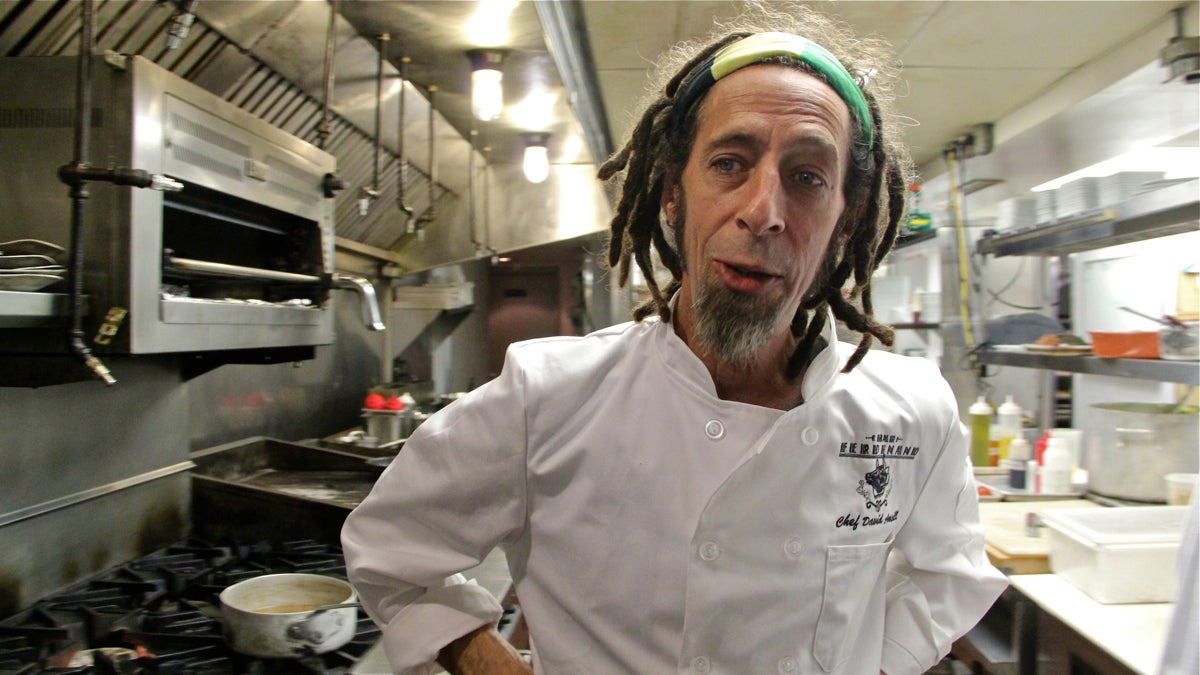Behind the scenes at Philly restaurants, addiction is on the menu
Listen
David Ansill (Emma Lee/WHYY)
During the past two weeks, you may have dined out during Restaurant Week at one of Philadelphia’s eateries.
You order your three courses, choose a bottle of wine. Everything seems just right. The servers are buzzing, the hostesses are smiling, and the kitchen is rocking.
What you may not realize is, chances are surprisingly good that some of the staffers swirling around you either have a drug or alcohol problem, or are on the path to one.
Yes, that’s right. It could be the nice young woman who filled your water glasses and told you the specials, the man who brought you more bread, the bartender who helped you choose the right cocktail, or the chef, who’s crafting your meal.
Addiction is as big a part of Philadelphia’s bustling restaurant scene as Zagat ratings and BYOB’s.
Restaurant servers, bartenders and cooks spend hours surrounded by alcohol. Their job is to cater to people who often are using drink to fuel a good time.
According to data from the U.S. Department of Health and Human service, drug and alcohol abuse in the food service industry is among the highest of any occupation. The department’s data indicate that roughly 17 percent of restaurant workers use illegal drugs ― roughly twice the national average. Rates of heavy alcohol use also far exceed the national norm.
Meanwhile, they themselves work long, stressful shifts that don’t end until two or three in the morning.
Jen, a 21-year old Philadelphia waitress, knows that routine all too well. And she knows how a lot of people cope with the job.
“Drugs affect everyone in this business,” she said.
She asked to stay anonymous to protect her privacy and her job because, after going into recovery, she works at a Philly diner. She said she wonders how long she’ll be able to stay clean while also dealing with daily work stresses — from time-consuming customers who tip just a few bucks on a $70 check to unsympathetic bosses who schedule her to work shifts she’s told them she can’t do.
“Whatever it is – that ‘cigarette’ is waiting for me.” she says. “Same thing with drugs.”
Food-service workers rank near the top of the list of occupations with heavy alcohol abuse and illicit drug use. Philadelphia food industry workers say that includes cocaine, prescription pills like Percocet, Oxycontin, Adderal and heroin.
A cultural bent to drink
The nature of the job combines with its social traditions to feed the problem.
At some establishments, sympathetic bartenders keep drinks flowing for servers and cooks while on the job. The free “shift drink” is a well-established tradition at many places; when the night ends and the customers leave the bar, the wait staff sticks around and drinks together.
Restaurant workers say the problem isn’t that first free drink; it’s the five or 10 that come after it.
Industry veterans say drugs are readily available, too, if you know whom to ask.
David Gastfriend, CEO at the Treatment Research Institute, an alcohol and drug research and policy organization based in Philadelphia, says the job has all the ingredients for temptation:
“They’re waiting on tables late into the evening, they finish up at 11, 12, 1 a.m. and then they’ve got to somehow unwind and calm down and prepare for sleep. And that’s difficult to do.”
So Gastfriend said, when waiters and waitresses want to unwind after a late shift, they turn to the only people they know are still awake and up for a drink, or four.
A seductive environment
For restaurant workers who are trying to kick the habit, maintaining their income can mean having to return to the same workplace where they fell to temptation.
He said workers in the gaming industry face a similar dilemma.
So do nurses, though their drug of choice tends to be opiates, said Shane Moes of the “Livengrin Foundation,” an addiction treatment facility in Pennsylvania. He said proximity is important: the closer an addicted person is to their substance of choice, the more the wanting part of the brain takes over:
“When you’re in early recovery, in particular, [the brain] is a very weak muscle: ‘I’m trying to do something different than I have rehearsed over and over and over.”
Moes said it’s taxing mentally to try to move against momentum that’s been well-rehearsed.
Another issue: In the food industry, workers often do not have health coverage, or at least coverage that pays for addiction treatment.
Trying a new recipe
From within Philly’s restaurant scene, some are doing what they can to change the culture.
Restaurant owner Steve DiFillippo said he has a zero tolerance policy for employees at his string of Northern Italian restaurants, which operate in Philadelphia, Boston, Atlanta, Manhattan, and other cities. “When I first started — Jeez, it’s been almost 30 years now since I started Davio’s — we would have drinks after work. You know, everyone would hang out at the bar and it was crazy.”
DiFillippo said he long ago got rid of the traditional “shift drink.” He takes other steps too. DiFillippo said he has a lot of employees who are in recovery and he requires employees with a drinking problem to provide proof they have entered Alcoholics Anonymous and are attending weekly meetings.
Jen, the veteran Philly waitress, said she sees plenty of younger workers head down the same path she traveled. The same young women who “come in with sparkly eye shadow on and red lipstick on and big earrings,” have transformed right in front of her, she says.
“I’ve seen girls go from completely sober fresh out of high school – never drank, never smoked a day in their lives – they’re full blown alcoholics right now.”
It’s the bosses, too
Unlike at some jobs, part of the problem at restaurants can be that the boss is right there with the staff, drinking or doing drugs. That point got underlined vividly a month ago when celebrated local chef Michael Solomonov, founder of Zahav, came out as a drug addict in the pages of the Sunday New York Times.
Chef David Ansill is a Philly restaurant industry veteran. He said he doesn’t really drink at home. But when he gets to work he’s singing — or rather drinking — a different tune.
“During a day, I can drink a bottle and half. You know, little sips. Like the glass I have in front of me here. In legal terms, medical terms, I’m an alcoholic. I look forward to it. Am I functional? Completely.”
Ansill said he has toned down his whiskey-drinking habit because he no longer felt like he could handle it physically. But he said he’s seen plenty of young restaurant workers who party every night and get burned out:
“I’ve seen kids that I’ve worked with that are in their 20’s and early 30’s that look worse than I do. Know what I mean? Just stop, just stop already. You have to be able to maintain a level of professionalism and to make this a career.”
Ansill said a lot of young restaurant workers assume their stay in the industry will be short, until they find a “real job.’
So he said, they figure: Why not take advantage of the easy access to alcohol while they can?
And, that, for all too many, can mark the start of a lifelong struggle.
Restaurant workers of course are not alone in their addiction struggles. This week President Obama marks the 25th Anniversary of “National Recovery Month.”
WHYY is your source for fact-based, in-depth journalism and information. As a nonprofit organization, we rely on financial support from readers like you. Please give today.




